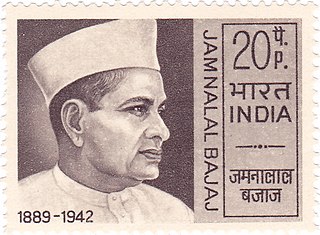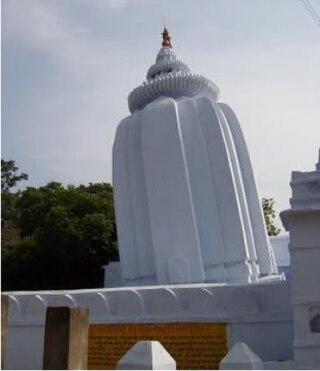Related Research Articles

Odisha, formerly Orissa, is an Indian state located in Eastern India. It is the 8th largest state by area, and the 11th largest by population. The state has the third largest population of Scheduled Tribes in India. It neighbours the states of Jharkhand and West Bengal to the north, Chhattisgarh to the west, and Andhra Pradesh to the south. Odisha has a coastline of 485 kilometres (301 mi) along the Bay of Bengal in Indian Ocean. The region is also known as Utkala and is mentioned by this name in India's national anthem, "Jana Gana Mana". The language of Odisha is Odia, which is one of the Classical Languages of India.

Jyotirao Govindrao Phule was an Indian social activist, businessman, anti-caste social reformer and writer from Maharashtra. His work extended to many fields, including eradication of untouchability and the caste system and for his efforts in educating women and oppressed caste people. He and his wife, Savitribai Phule, were pioneers of women's education in India. Phule started his first school for girls in 1848 in Pune at Tatyasaheb Bhide's residence or Bhidewada. He, along with his followers, formed the Satyashodhak Samaj to attain equal rights for people from lower castes. People from all religions and castes could become a part of this association which worked for the upliftment of the oppressed classes. Phule is regarded as an important figure in the social reform movement in Maharashtra.The honorific Mahātmā, was first applied to him in 1888 at a special program honoring him in Mumbai..

Dalit, also previously known as untouchable, is the lowest stratum of the castes in the Indian subcontinent. Dalits were excluded from the four-fold varna system of Hinduism and were seen as forming a fifth varna, also known by the name of Panchama. Dalits predominantly follow Hinduism, with significant populations of the adherents of Buddhism, Sikhism, Christianity, and Islam. Scheduled Castes is the official term for Dalits, who get reservation under Positive discrimination, as per the constitution of India.

Sevagram is a town in the state of Maharashtra, India. It was the place of Mahatma Gandhi's ashram and his residence from 1936 to his death in 1948. After Sabarmati, Sevagram Ashram holds immense importance due to the residence of Mahatma Gandhi.
The Temple Entry Proclamation was issued by Maharaja Chithira Thirunal Balarama Varma on November 12, 1936. The Proclamation abolished the ban on the so-called 'low caste people' or avarnas from entering Hindu temples in the Princely State of Travancore, now part of Kerala, India.

Jamnalal Kaniram Bajaj was an Indian industrialist. He founded the Bajaj Group of companies in the 1920s, and the group now has 24 companies, including six that are listed on the bourses. He was also a close and beloved associate of Mahatma Gandhi, who is known to have often declared that Jamnalal was his fifth son.
Sambalpur is the fifth largest city in the Indian State of Odisha. It is located on the banks of river Mahanadi, with a population of 335,761. Prehistoric settlements have been recorded there. It is the home of the Sambalpuri sari.

Nandanar, also known as Thirunaallaippovaar and Tirunallaipovar Nayanar, was a Nayanar saint, who is venerated in the Hindu sect of Shaivism. He is the only Paraiyar saint in the Nayanars. He is generally counted as the eighteenth in the list of 63 Nayanars. Like the other Nayanars, he was a devout devotee of the god Shiva.
Guruvayur Satyagraha took place in (1931–32) and was a Satyagraha in the present Thrissur district, which was then part of Ponnani Taluk of Malabar district, now part of Kerala, which was an effort to allow entry for untouchables into the Guruvayur Temple. It was led by K. Kelappan, who undertook a hunger strike for 12 days until it was abandoned because of a request from Mahatma Gandhi and the Indian National Congress. Mahatma Gandhi hailed it as "the miracle of modern times" and "a smriti which is peoples charter of spiritual emancipation". K. Kelappan, A.K Gopalan, P. Krishna Pillai, Mannathu Padmanabhan and N.P Damodaran Nair were the leaders of that agitation. It was a failure, For another four years, nothing much changed in Guruvayur or in the rest of the region that today constitutes the State of Kerala. It was only in 1936 that many temples in Kerala were opened for all to use.
Persecution and discrimination against Dalits has been observed in the countries such as Bangladesh, India, Pakistan, Nepal, the UK, and the US.

Nuakhai is an agricultural festival mainly observed by people of Western Odisha in India. Nuakhai is observed to welcome the new rice of the season. According to the calendar it is observed on panchami tithi of the lunar fortnight of the month of Bhadrapada or Bhadraba (August–September), the day after the Ganesh Chaturthi festival. This is the most important social festival of Western Odisha and adjoining areas of Simdega in Jharkhand, where the culture of Western Odisha is much predominant because there are so many things learn about agriculture with Human behavior also, nuakhai is very big festival and a unique festival also that's why every Indian knowing to Nuakhai History if you love any food then.

Elanthoor is a village in Pathanamthitta district of the Southern State of Kerala, India. Situated halfway between Kozhencherry and Pathnamthitta, the area was part of the Kingdom of Travancore presumably since 1820. This peaceful rural belt has a significant place in the history of the freedom movement of the country and has made notable contributions to the film industry. It has been argued that the expression "Ellangalude Oor" shortened by over has become "Elanthoor". "Ellangalude Oor" would mean "aggravation of settlements" or a region of concentration of houses.

The Leaning Temple of Huma in India is one of only a very few leaning temples in the world. It is located in Huma, a village situated on the bank of the Mahanadi, 23 km south of Sambalpur in the Indian state of Odisha. The temple is dedicated to the Hindu god Lord Bimaleshwar.

Parbati Giri, daughter of Dhananjay Giri. Nicknamed the Mother Teresa of Western Odisha, was a prominent female freedom fighter from Odisha, India. The women freedom fighters of Odisha played a significant role in the Indian Freedom Struggle.

Ramadevi Choudhury(Odia: ରମାଦେବୀ ଚୌଧୁରୀ), also known as Rama Devi, was an Indian freedom fighter and a social reformer. She was called Maa (Mother) by the people of Odisha. The Ramadevi Women's University in Bhubaneswar has been named after her.

Gandhi Memorial Museum, established in 1959, is a memorial museum for Mahatma Gandhi located in the city of Madurai in Tamil Nadu, India. Known as Gandhi Museum, it is now one of the five Gandhi Sanghralayas in the country. It includes a part of the blood-stained garment worn by Gandhi when he was assassinated by Nathuram Godse.

Binod Kanungo (1912–1990) was an Odia author, freedom fighter, Gandhian, educator, social reformer and compiler of the Gyana Mandala, which is the greatest encyclopaedia in the Odia language. He also won the Odisha Sahitya Akademi Award for his travelogue Runa Parishodha (1983). He was also a veteran freedom fighter and notable educationist. He was awarded with India's fourth highest civilian honour "Padmashree". He died on 22 June 1990.
Harijan Sevak Sangh is a non-profit organisation founded by Mahatma Gandhi in 1932 to eradicate untouchability in India, working for Harijan or Dalit people and upliftment of Depressed Class of India. It is headquartered at Kingsway Camp in Delhi, with branches in 26 states across India.
Sisua is a medium-sized village in the Salipur taluk/mandal/tehsil/block of Cuttack district in the state of Odisha, India, close to the new Sisua Village Jagannath Temple. The village lies South of Cuttack to Kendraparda road left of Sisua village road if traveling South. As of 2009 Kantapara is the gram panchayat of Sisua village

Gopabandhu Choudhuri was an Indian activist, social worker and freedom fighter. He participated in the Non-cooperation Movement, Civil Disobedience movement.
References
- ↑ "7 new sites to get tourist spots recognition in S'pur". www.dailypioneer.com. The Pioneer. Archived from the original on 1 October 2020. Retrieved 1 October 2020.
- ↑ "Mahatma Gandhi, Chinese Kali, and a Sachin Tendulkar temple: 10 unusual temples in India for the unconventional Indian gods". www.news18.com. News18. Archived from the original on 1 October 2020. Retrieved 1 October 2020.
- ↑ "Dalits build Gandhi temple in Sambalpur". www.timesofindia.indiatimes.com. The Times of India. Archived from the original on 7 October 2016. Retrieved 1 October 2020.
- ↑ Subrat Mohanty. "Ramdhun to recall Bapu". www.telegraphindia.com. The Telegraph. Archived from the original on 1 October 2020. Retrieved 1 October 2020.
- ↑ "Mahatma Gandhi Temple in Bhatra, Sambalpur". www.mysambalpur.in. Archived from the original on 1 October 2020. Retrieved 1 October 2020.